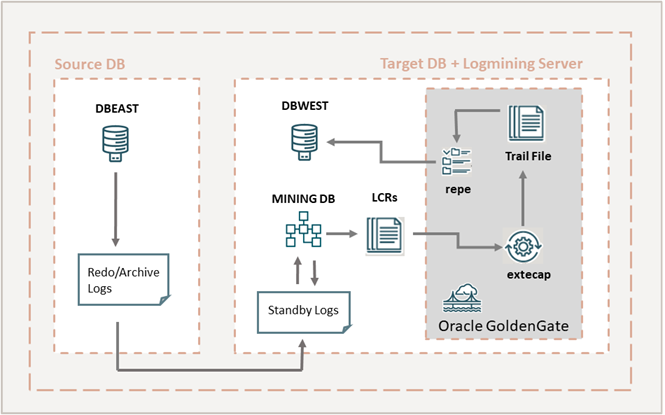About Integrated Extract
The Oracle GoldenGate Integrated Extract process interacts directly with a database logmining server to receive data changes in the form of logical change records (LCRs).
The following diagram illustrates the configuration of Extract.

Description of the illustration downstream_ext.png
Some of the additional features of Oracle GoldenGate Extract are:
-
Extract is fully integrated with the database, allowing seamless interoperability between features such as Oracle RAC, ASM, and TDE.
-
Extract uses the database logmining server to access the Oracle redo stream, with the benefit of being able to automatically switch between different copies of archive logs or different mirrored versions of the online logs. Thus, capture can transparently handle the absence of a log file caused by disk corruption, hardware failure, or operator error, assuming that additional copies of the archived and online logs are available
-
Extract enables faster filtering of tables.
-
Extract handles point-in-time recovery and RAC integration more efficiently.
-
Extract features integrated log management. The Oracle Recovery Manager (RMAN) automatically retains the archive logs that are needed by Extract.
-
Extract supports capture from a multitenant container database and from per-PDB capture mode.
-
Extract and Replicat (integrated) are both database objects, so the naming of the objects follow the same rules as other Oracle database objects. See Specifying Object Names in Oracle GoldenGate Input in Oracle GoldenGate Microservices Documentation.
-
When Extract is running from a remote system, Oracle GoldenGate automatically enables cross endian interoperability. This implies that if the endian value where Extract is running is different from the endian value where the Oracle database is running, then the cross endian support is automatically enabled. For cross endian Extract to work, the compatibility parameter of the source database must be 11.2.0.4 or higher.
- Each Extract group must process objects that are suited to the processing mode, based on table data types and attributes. No objects in one Extract can have DML or DDL dependencies on objects in the other Extract.